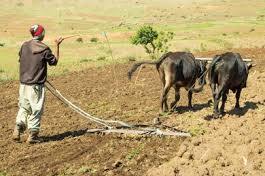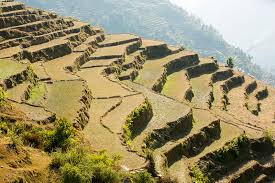SUBSISTENCE FARMING-HISTORY & TYPES
INTRODUCTION
Subsistence farming is that form of farming in which nearly all of the crops or livestock raised are used to maintain the farmer and the farmer’s family. It means farmers grow food crops to meet the needs of themselves and their families; little or nothing is produced for sale or trade.
In subsistence agriculture, farm output is subjected to survival and is mostly for local requirements with little or no surplus. Agriculture planning is made principally with the view towards what will be families’ need during the subsequent year, and secondarily toward market prices.


Subsistence farming/Subsistence agriculture does not provide consistent economic growth and development, the accumulation of capital, or the specialization of labor due to little or no surplus. Subsistence crops are usually organic due to lack of proper and quality inputs.
HISTORY
- Subsistence agriculture was predominant in Asian continent especially India and later emerged in various parts of the developing countries.
- Earlier it was the dominant mode of food production in the world until commercialization took place widely.
- Presently this farming is existed in part of Africa, Southeast Asia, and parts of South and Central America, is an extension of primitive foraging practiced by early civilizations.
- Historically, most early farmers engaged in some form of subsistence farming to survive. As the domestication of certain plants and animals evolved, population densities rose and intensive farming methods developed, the movement towards commercial farming and industrialization became more prominent.
- In some countries like Botswana, Bolivia, Rwanda, Sierra Leone, Zambia, Mexico, and Vietnam still subsistence farming continues to be a way of life far into the twenty-first century. Though, as urban centers grew, agricultural production became more specialized and commercial farming developed, with farmers producing a sizable surplus of certain crops, which they traded for manufactured goods or sold for cash.
TYPES OF SUBSISTENCE FARMING
- Shifting cultivation– Here land is rotated but crop is fixed. In this type of agriculture, a patch of forest land is cleared by a combination of felling and burning, and crops are grown. After 2–3 years the fertility of the soil begins to decline, the land is abandoned and the farmer moves to clear a fresh piece of land elsewhere in the forest as the process continues. While the land is left fallow the forest regrows in the cleared area and soil fertility and biomass is restored. After a decade or more, the farmer may return to the first piece of land.
Shifting cultivation is also called dredd in India, ladang in Indonesia, milpa in Central America and Mexico and jhumming in North East India. Practiced in northern state of India, Jharkhand, M.P, and hilly areas. - Primitive farming- This type of farming is done on self-sufficient basis and farmers grow food only for themselves and their families. Some small surpluses may be either exchanged by barter or sold for cash. The resultant economy is thus static with little chance for improvement, but there is a high degree of rural independence because farmers are not tied to landlords or to trading centres. This form of agriculture is widely practiced by many tribes of the tropics, especially in Africa, in tropical South and Central America, and in South-East Asia.
- Nomadic farming- In this type of farming people migrate along with their animals from one place to another in search of fodder for their animals. Generally they rear cattle, sheep, goats, camels and/or yaks for milk, skin, meat and wool. This way of life is common in parts of central and western Asia, India, east and southwest Africa and northern Eurasia.
Examples are the nomadic Bhotiyas and Gujjars of the Himalayas. They carry their belongings, such as tents, etc., on the backs of donkeys, horses, and camels. In mountainous regions, like Tibet and the Andes, yak and llama are reared. Reindeer are the livestock in arctic and sub-arctic areas. Sheep, goats, and camels are common animals, and cattle and horses are also important.
FUTURE PROSPECTS
- Historically and currently a difficult way of life, subsistence farming is considered by many a backward lifestyle that should be transformed into industrialized communities and commercial farming throughout the world in order to overcome problems of poverty and famine.
- Subsistence agriculture can be used as a poverty alleviation strategy, specifically as a safety net for food-price shocks and for food security. Poor countries are limited in fiscal and institutional resources that would allow them to contain rises in domestic prices as well as to manage social assistance programs, which is often because they are using policy tools that are intended for middle- and high-income countries. Low-income countries tend to have populations in which 80% of poor are in rural areas and more than 90% of rural households have access to land, yet a majority of these rural poor have insufficient access to food.
- Subsistence agriculture can be used in low-income countries as a part of policy responses to a food crisis in the short and medium term, and provide a safety net for the poor in these countries.
SUBSISTENCE FARMING AND THE MODERN WORLD
- Despite its difficulties, subsistence farming remains a part of the modern world today. It offers only option to prevent starvation and famine for many underdeveloped nations.
- Subsistence farming has been argued to be economically efficient within various subtropical regions of Columbia and Papua New Guinea. Under these subtropical conditions, rainfall levels are often high and various crops can be produced year round. Due to these conditions, production levels often prove adequate enough to provide for small subsistence farming communities.
- Subsistence farming as practiced in many parts of the world in the past and today is not the ideal model. Nonetheless, subsistence farming generally recognizes the cycles of renewability in nature and works in harmony with them to maintain productivity. Ultimately, sustainability depends upon harmony among people and with our environment.
Read more….
What is Agriculture & History of Agriculture
AGRICULTURE IN INDIA: Development & Present Scenario
GREEN REVOLUTION IN INDIA- ITS IMPACT
TYPES OF FARMING- SYSTEM OF FARMING
INTEGRATED FARMING SYSTEM
WHAT IS ORGANIC FARMING
CROPPING PATTERN-CROPPING SYSTEM
TYPES OF FARMERS-GOVERNMENT INITIATIVES
KRISHI VIGYAN KENDRA